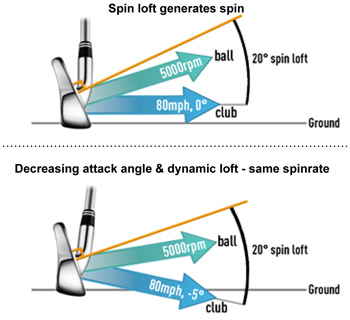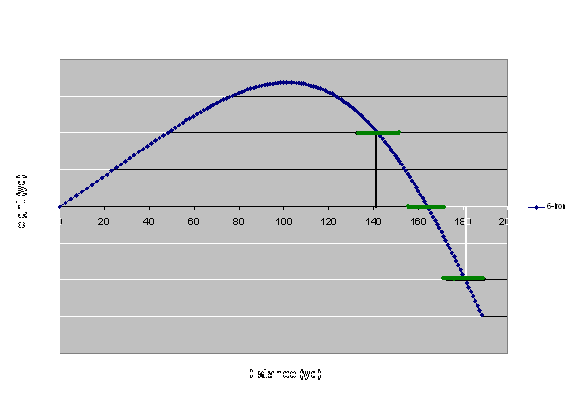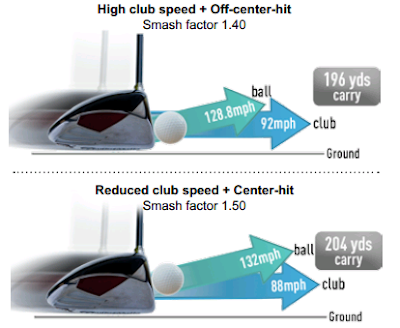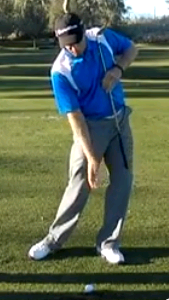If you haven't checked out part one of this series please do so before attempting to read this section.
"The golf ball does not know if the player is fifteen or seventy-five years old, it does not know if you are fifty pounds overweight. All it knows is what the club tells it at impact.
How good are the tour pros at getting these numbers right?
The tour pros are amazingly good at being consistent with their club path and face angle. Of all the tour pro data I have ever seen, Jim Furyk is the one with the most consistent club path and face angle (about 0.4 degrees in consistency with his driver), and in addition Furyk’s average club path and face angle for the data I have seen are exactly 0 degrees. I am convinced that this is one of the reasons Furyk is always in the top rankings on fairways hit. Many of the tour pros are far from Furyk’s 0 degree club path/face angle standards. A big part of the pros either hit a small draw or small fade deliberately. Among tour pros, club path ranges from about -6 degrees to +6 degrees. Kenny Perry has an inside-out club path of +6 degrees with his driver and deliberately hits a big draw, while on the other side, Colin Montgomery has an outside-in club path of around -6 degrees on his drives and deliberately hits a big fade.
PGA & LPGA Tours Trackman Insight
The Physics Behind A Straight Shot
The Physics Behind A Straight Shot Part 2
Trackman Fundamentals
Why is the average PGA TOUR attack angle with the driver negative when it is better to hit up on the ball?
To say a golfer should hit up on the ball with the driver has always been in the pursuit of maximizing distance. Hitting up, or having a positive attack angle, with the driver allows the golfer the potential to maximize their distance by creating the sought after high launch, low spin shot result. However, there is still much debate and theory in the teaching world as to what creates the straightest shot most consistently. It is widely understood that a squarely hit shot with zero face angle and zero path results in a straight shot, but what swinging motion makes this achievable the highest percentage of the time?
The one thing that is certain is that a player’s horizontal swing plane (HSP) must be positive with the driver if the player is going to hit up on the ball and hit a straight shot. For every other club in the bag (assuming negative attack angle), the HSP must be negative in order to zero out club path, thus hit an effective straight shot.
So, is it harder to make the same swing and impact when hitting up on the ball? Or is it harder to repeat this swing and impact because Driver is the only club in the bag swung this way? Or is it just as easy to repeat this swing if the differences were understood and it were practiced correctly? Or more simply, it may just be the case that Tour Pros can generate so much club speed, that they can afford to trade off some distance result for accuracy and consistency. See the July 2009 newsletter article, The Physics Behind A Straight Shot Part 2, for more information on why the HSP must change between a shot with a negative attack angle and positive attack angle.
What is the correct distance gap between clubs?
The USGA allows for a maximum of 14 clubs including the driver and putter, so it is up to the golfer to determine the best allocation of these remaining 12 clubs. A golfer with Tour Pro club speed will have more yardage range to cover with these clubs than a golfer whose driver speed is 90 mph. First, a golfer should determine the highest lofted wedge they can be effective with and then determine how far a standard full shot carries with that club. This will give the low end of the range. If the golfer subtracts this distance from how far an average drive carries, this will give the range of yardages that need to be covered. If the golfer would prefer evenly spaced gaps between all clubs they should take the calculated range and divide by 12.
This would mean there would be a gap of 16 yards between each club if a golfer hit the ball as far as the average Tour Pro and wanted evenly spaced gaps. Applying this theory is just one of many ways that a player can setup their bag to benefit their game the most. It could even end up that a golfer with lower club speed may have the gaps structured the way they want and end up with an extra
club or two left to use. This situation could allow for a special chipping club or bunker club. It could even allow for the golfer to carry 2 drivers, one that has a flatter trajectory and runs more and one that maximizes carry for forced carries or other reasons (Phil Mickelson did this once!).
Spin Loft & Angle of Attack
http://www.youtube.com/watch?v=rcHUF_-hWcA
Spin loft is the relationship between the dynamic loft and the angle of attack. The ball will always launch in the region between these two variables (known as the D-plane) but only slightly lower than the dynamic loft. For a 90mph swinger, he has to launch the ball at 14 or 15 degrees to maximize distance. But in order to do this, the dynamic loft must be at 16 or 17 degrees (so add 2 degrees from vertical launch = dynamic loft). IF those angles produce the optimum spin rate for your ball speed and we know that the dynamic loft needs to be 17 degrees up, then the bottom vector, the angle of attack must come up (so hitting up on the ball to maximize distance).

Trackman Fundamentals
Why is the average PGA TOUR attack angle with the driver negative when it is better to hit up on the ball?
To say a golfer should hit up on the ball with the driver has always been in the pursuit of maximizing distance. Hitting up, or having a positive attack angle, with the driver allows the golfer the potential to maximize their distance by creating the sought after high launch, low spin shot result. However, there is still much debate and theory in the teaching world as to what creates the straightest shot most consistently. It is widely understood that a squarely hit shot with zero face angle and zero path results in a straight shot, but what swinging motion makes this achievable the highest percentage of the time?
The one thing that is certain is that a player’s horizontal swing plane (HSP) must be positive with the driver if the player is going to hit up on the ball and hit a straight shot. For every other club in the bag (assuming negative attack angle), the HSP must be negative in order to zero out club path, thus hit an effective straight shot.
So, is it harder to make the same swing and impact when hitting up on the ball? Or is it harder to repeat this swing and impact because Driver is the only club in the bag swung this way? Or is it just as easy to repeat this swing if the differences were understood and it were practiced correctly? Or more simply, it may just be the case that Tour Pros can generate so much club speed, that they can afford to trade off some distance result for accuracy and consistency. See the July 2009 newsletter article, The Physics Behind A Straight Shot Part 2, for more information on why the HSP must change between a shot with a negative attack angle and positive attack angle.
What is the correct distance gap between clubs?
The USGA allows for a maximum of 14 clubs including the driver and putter, so it is up to the golfer to determine the best allocation of these remaining 12 clubs. A golfer with Tour Pro club speed will have more yardage range to cover with these clubs than a golfer whose driver speed is 90 mph. First, a golfer should determine the highest lofted wedge they can be effective with and then determine how far a standard full shot carries with that club. This will give the low end of the range. If the golfer subtracts this distance from how far an average drive carries, this will give the range of yardages that need to be covered. If the golfer would prefer evenly spaced gaps between all clubs they should take the calculated range and divide by 12.
This would mean there would be a gap of 16 yards between each club if a golfer hit the ball as far as the average Tour Pro and wanted evenly spaced gaps. Applying this theory is just one of many ways that a player can setup their bag to benefit their game the most. It could even end up that a golfer with lower club speed may have the gaps structured the way they want and end up with an extra
club or two left to use. This situation could allow for a special chipping club or bunker club. It could even allow for the golfer to carry 2 drivers, one that has a flatter trajectory and runs more and one that maximizes carry for forced carries or other reasons (Phil Mickelson did this once!).
Maximizing Distance
Anytime you hit the ball on the heel or the toe, you lose ball speed and thus a little distance.The optimal combination of ball speed, launch angle, and spin rate needed to maximize driving distance for a particular golfer are primarily dictated by the golfer’s club speed and attack angle.
a) The reason has to do with a tradeoff between ball speed, launch angle, and spin rate. Distance is maximized with a high ball speed, high launch angle, and low spin rate
– however, increasing launch angle by increasing the dynamic loft has the side-effect of increasing spin rate and decreasing ball speed. So, a tradeoff must be made, and the optimal tradeoff depends on how an individual delivers the club to the ball. Maximizing ball speed also implies making center impact – or at least close to center impact – as well squaring up club path and face angle.
b) TrackMan helps pinpoint the tradeoff because it precisely measures club speed and attack angle for all golfers. This information can be used to determine the optimal launch conditions for a particular golfer, which again, can be validated by TrackMan since it also measures ball speed, launch angle, and spin rate, along with carry to validate the end result.
c) As an example, someone with a club speed of 90 mph and an attack angle of -5 degrees would maximize carry distance with a ball speed of 129 mph, launch angle of 11.1 degrees, and spin rate of 3690 rpm. Meanwhile, someone else with the same club speed of 90 mph, but an attack angle of +5 degrees would maximize carry distance with a ball speed of 132 mph, launch angle of 16.4 degrees, and spin rate of 2630 rpm. Note in this example, the golfer who hit up on the ball would end up with more carry: 214 versus 191 yards.
Spin Loft & Angle of Attack
http://www.youtube.com/watch?v=rcHUF_-hWcA
Spin loft is the relationship between the dynamic loft and the angle of attack. The ball will always launch in the region between these two variables (known as the D-plane) but only slightly lower than the dynamic loft. For a 90mph swinger, he has to launch the ball at 14 or 15 degrees to maximize distance. But in order to do this, the dynamic loft must be at 16 or 17 degrees (so add 2 degrees from vertical launch = dynamic loft). IF those angles produce the optimum spin rate for your ball speed and we know that the dynamic loft needs to be 17 degrees up, then the bottom vector, the angle of attack must come up (so hitting up on the ball to maximize distance).
- tee ball up in the air
- ball position must be forward
- axis tilt with the body, at impact the spine is tilted away from the target. Trackman MAestro and Grant Waite do not prescribe the reverse K position at address (where you are tilting back far way from the ball)
- Spine almost vertical at address, but the massive pelvic shift tilts the spine back at impact
- A great driver at impact will not have a vertical spine

Smash Factor = Efficiency
Generally speaking, to maximize ball speed it is more important to improve centeredness of impact than to increase club speed.
a) An off-center impact is less efficient in transferring energy from the club to the ball, thus some of the power the club speed is lost, resulting in a lower initial ball speed and consequently less carry distance.
b) TrackMan can help by reporting smash factor, which correlates highly with impact. Smash factor describes the efficiency of impact and equals the ratio ball speed divided by club speed. Note that in addition to impact, the spin loft and club and ball properties also affect smash factor.
c) This is important because it is common for amateurs to “over-swing”. While over-swinging might increase club speed, it may negatively affect centeredness of impact, and net out in decreased ball speed, resulting in reduced carry distance.
d) As an example, assume someone with a club speed of 90 mph and smash factor of 1.45 can drive a ball so it has a carry of 200 yards. Increasing the club speed to 92 mph but reducing smash factor to 1.40 due to off center hit would result in a new carry of only 196 yards. Instead of increasing the club speed, the golfer could lower the club speed to 88 mph in order to swing under control and increase his or her impact, thereby increasing the smash factor to 1.50 resulting in a carry of 204 yards.
e) TrackMan has seen that for drives, golfers should attempt to achieve a smash factor of 1.47 or higher (look at PGA & LPGA tour avgs above).
Notice how important a center-hit is; a reduced club head speed of 4mph with a center-hit can produce 8 extra yards of carry which is a result of more ball speed. And assuming that each mph = 2.5 extra yards

Flighting Short Irons Lower
In the professional golf world, the best wedge and short iron players have the ability to control the trajectory of the ball flight. The ability to flight the ball lower requires the dynamic loft at impact to be lower than the loft on the club (ex: launches at 40 degrees with a 56 degree wedge). This will in turn require the golfer to hit down on the ball more causing the attack angle to be more negative. With this knowledge, we can debunk the myth that just hitting down on the ball makes the ball go up. It is much more complicated than that because we need to take into account the dynamic loft at impact, the spin rate, and the angle of attack.
Here former PGA tour pro Grant Waite demonstrates the lower flighted short iron. Have the ball back in the stance with the clubshaft leaning forward. Then maintain that angle with the back of the right wrist (there is a little cup) while turning through the shot.
This shot is a very handy addition to a golfers arsenal as they can shave off those few extra yards when they are in between clubs, keep it under the wind, and control the spin and distance. Watch the motions of Zach Johnson, Tiger Woods, Mike Weir, Phil Mickelson when they have a short iron or wedge into the green. These guys are amazing at controlling the distance and they even use this technique on shorter pitches into the green.
Leaning Back To Hit The Ball Higher?
To hit the ball higher, you need to shallow the angle of attack with more dynamic loft. See the "Law of the Draw" in Sean Foley's Part 2, because the draw shot launches the ball higher. You do not want to tilt back to hit the ball higher as this will result in striking to become more difficult because your center of gravity behind the ball causes the bottom of the arc moves behind the ball. If your weight is moving forward on the left foot in the downswing it is easier to swing "in-out", while if your weight is back it is easier to swing "out to in."
Incidental tilt in the upper body occurs when you are shifting your lower weight, lower axis forward. You do not want to tilt back in an effort to hit up on the ball (especially with the driver). See drill for "steep angle of attack with driver."
You can indeed have a high dynamic loft with a steep angle of attack and you can have a high dynamic loft with a shallow angle of attack.
How Elevation Affects the Distance

"The graph above was produced using a projectile model for a 6-iron. The green horizontal lines represent placements of the golf hole's green, relative to the position from which the ball is hit. If the hitting position and green are at the same elevation, the ball lands at about 162 yards."
- If hitting uphill to a green elevated by 20 yards, the ball lands on the green at a horizontal distance of about 141 yards. Thus, the effective distance of the 6-iron is 21 yards shorter.
- If hitting downhill to a green, 20 yards below, the ball lands onto the green at a horizontal distance of about 180 yards. Thus, the effective distance of the 6-iron is 18 yards longer.
- For simplicity think of a 1:1 yard ratio. So when hitting into a green about 5 yards uphill think that your normal 160 yard 6 iron will go 155 yards.
How a golf ball is affected by wind
There's an old Scottish expression. "If there's nae wind, it's nae golf." A variety of wind conditions and a
breeze make a big difference in how to play any shot. A strong wind at your back, for example, can help you
hit the green of a par five in two shots; the same wind in the face might make three shots almost impossible.
To score your best, you must respect and understand the wind's effect on the ball. Here are the basics.
Headwinds
The toughest wind is the one that blows directly into your face. Knowing that you'll lose some distance, usually you swing harder, which compounds the wind's effects by creating a bad shot.
The toughest wind is the one that blows directly into your face. Knowing that you'll lose some distance, usually you swing harder, which compounds the wind's effects by creating a bad shot.
Instead of letting the wind beat you psychologically, determine how much distance you're giving up, take enough extra club and concentrate on making solid contact. Don't be shy about taking enough stick. A good rule of thumb is to add one club (or 10 yards) for about every 10 miles per hour of wind (1:1 ratio between distance and miles per hour). For example, if you're looking straight into a 30 mph gale, take three more clubs; if the shot is a 7-iron in no wind, hit a 4-iron. Be sure to make a smooth swing.
A headwind also magnifies the curve of a slice or fade, so be sure to allow for it. The stronger the wind, the greater effect on your shot. A right-to-left hook or draw travels on a lower trajectory, so its flight is less affected by headwind.
Tailwinds
Teeing off with a wind behind you would seem to be ideal: The ball will stay in the air longer for more distance. But a following wind will bring the ball down on a shallower angle than normal, so it will come in "hot" and roll more than usual.

Crosswinds
There are two methods for handling a crosswind: Either work the ball into the wind, e.g. hit a left-to-right shot into a right-to-left breeze, or let the wind do the work. The latter method is easier.
There are two methods for handling a crosswind: Either work the ball into the wind, e.g. hit a left-to-right shot into a right-to-left breeze, or let the wind do the work. The latter method is easier.
Plan on the ball shifting approximately five yards for every 10 miles per hour of wind speed (1:2 ratio). For example, aim about 10 yards left of your target when hitting through into a 20 mph, left-to-right crosswind.
Remember that a crosswind will effect the shape of the shot, which should have some bearing on your aim. Depending on the direction of the wind, it will either increase or decrease the amount of bend on a fade or draw.
Another great article on wind: http://heartlandgolfschools.com/Lessons/2012/07/27/actual-yardage-vs-effective-yardage/
Some Trackman Data
 Here is European Tour Player and former Ryder Cup player Eduardo Molinari. The face to path number tells where the ball will draw/ hook or fade/ slice. Notice that it is simple subtraction from:
Here is European Tour Player and former Ryder Cup player Eduardo Molinari. The face to path number tells where the ball will draw/ hook or fade/ slice. Notice that it is simple subtraction from:
(FACE ANGLE)-(CLUB PATH)= FACE TO PATH
-3.0-(-0.9)=-2.1
This shot was one that started slightly left and then curved further left.
A Negative club path always starts to the left of target, while a Positive club path starts to the right of target.
A Negative Face Angle always is closed to target, while a Positive club path is open to the target
*Note that in these pictures, the target is the center of the fairway.*
Here Mark shows how the angle
of attack with the driver affects the distance of tee shots. Attacking on the downswing = less distance
than on the upswing with the driver.
 Trackman numbers for Ian Poulter. Notice he hits his driver with a slight descending blow -1.5 degrees and thus his launch will be slightly lower than it could be if he were to hit on the upswing (say 1.5 degrees). This also results in less distance, but for him this gives him control (just look at that shot dispersion!).
Trackman numbers for Ian Poulter. Notice he hits his driver with a slight descending blow -1.5 degrees and thus his launch will be slightly lower than it could be if he were to hit on the upswing (say 1.5 degrees). This also results in less distance, but for him this gives him control (just look at that shot dispersion!). 










No comments:
Post a Comment